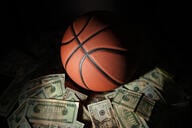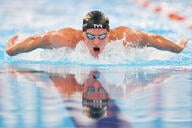You have /5 articles left.
Sign up for a free account or log in.
After a slight dip last year, Division I graduation rates are up again and have tied an all-time record 82 percent, the National Collegiate Athletic Association announced Thursday.
Athletes first hit the 82 percent mark two years ago, before dropping down to 81 percent last year.
The latest data reflect the NCAA’s Graduation Success Rate of athletes who entered college for the first time in 2006 and graduated within six years. (A GSR database searchable by sport, institution, conference and year can be viewed here.)
Unlike the Federal Graduation Rate, the GSR counts athletes who transfer out as graduates (it also accounts for athletes who transfer in), and consequently shows consistently better results. The six-year federal rate for the same cohort of athletes is 65 percent.
Last year, football and men’s basketball, which historically have reported the lowest graduation rates, exceeded the 70 percent mark for the first time. This year, football players in the Football Bowl Subdivision and the less athletically prestigious Football Championship Subdivision each climbed a percentage point, to 71 and 70 percent, respectively. And after a six-percentage-point leap last year, the rate for men’s basketball players dropped a point to 73 percent.
| Athlete Group | 2006 Entering Class GSR |
| Men's Basketball | 73% |
| Men's Basketball (White) | 83% |
| Men's Basketball (Black) | 68% |
| Football (FBS) | 71% |
| Football (FBS, White) | 84% |
| Football (FBS, Black) | 64% |
| Women's Basketball | 84% |
| Women's Basketball (White) | 92% |
| Women's Basketball (Black) | 78% |
But Walt Harrison, chair of the NCAA’s Committee on Academic Performance and president of the University of Hartford, is not too focused on any one sport or rate.
“I think the long view here is really good, and the GSR rates this year just reflect the fact that we are trending in the right direction,” Harrison said. “I’m not saying we’re finished with our work – I’d love to see us do even better – but we’re reaching a point in our maturity that we can take stock of the things we’ve done well and look at some of the things we can do better.”
NCAA officials have pushed colleges to provide additional and targeted support for athletes in those high-revenue sports of football and men’s basketball, which are more likely to enroll underprepared students under “special admit” policies. That way, athletes must only meet NCAA eligibility standards, which may be lower than the institution’s academic standards.
Black athletes have also been of special concern to NCAA officials, as they tend to graduate at rates lower than their white peers. This year, both groups graduated at record rates, but the rate for black students is still far lower: 64 percent, versus 84 percent among white players.
In baseball, another sport that has exhibited comparatively low graduation rates, the GSR stayed steady at 75 percent. Last year the baseball GSR jumped seven points.
Since the NCAA began collecting GSR data in 1995, overall graduation rates are up 11 percentage points, rates for black males are up 11 points, and men’s basketball and Football Bowl Series football rates are up 17 and 8 points, respectively.
The NCAA credits those increases to the GSR: More than 1,800 athletes in the 2006 cohort graduated than would have had the GSR remained at the 1995 cohort level, the NCAA says. In the last 12 years since the GSR’s inception, an additional 11,388 athletes graduated.
But it’s not a direct correlation. Rather, the GSR is related tangentially to the NCAA’s Academic Progress Rate, which measures athletes’ classroom performance and retention. While there’s no penalty for a low graduation rate, there are penalties of varying severity for teams with low APRs, so they serve as incentive to get players graduated within six years. The APR and other academic standards have risen over the years, leading to more graduates and in turn higher GSRs, the NCAA says.
| Division I Sport | Entering class, 2005-6 | Entering class, 2006-7 |
| Baseball | 75.1 % | 75.6 % |
| Men's Basketball | 74.1 % | 72.9 % |
| Women's Basketball | 83.7 % | 84.4 % |
| Women's Bowling | 61.0 % | 63.9 % |
| Women's Crew | 94.9 % | 93.0 % |
| Men's Cross Country / Track | 77.5 % | 73.9 % |
| Women's Cross Country / Track | 84.3 % | 84.9 % |
| Men's Fencing | 89.6 % | 85.4 % |
| Women's Fencing | 93.0 % | 93.3 % |
| Women's Field Hockey | 93.4 % | 91.3 % |
| Football (FBS) | 70.1 % | 71.0 % |
| Football (FCS) | 68.5 % | 69.6 % |
| Men's Golf | 82.1 % | 83.1 % |
| Women's Golf | 91.9 % | 91.4 % |
| Men's Gymnastics | 88.9 % | 92.9 % |
| Women's Gymnastics | 96.3 % | 94.7 % |
| Men's Ice Hockey | 82.8 % | 86.8 % |
| Women's Ice Hockey | 95.7 % | 94.8 % |
| Men's Lacrosse | 85.5 % | 87.1 % |
| Women's Lacrosse | 96.2 % | 94.3 % |
| Men's Rifle | 70.3 % | 90.9 % |
| Women's Rifle | 70.3 % | 90.9 % |
| Men's Skiing | 88.5 % | 83.3 % |
| Women's Skiing | 91.3 % | 91.7 % |
| Men's Soccer | 79.9 % | 83.3 % |
| Women's Soccer | 88.2 % | 88.7 % |
| Softball | 85.8 % | 85.6 % |
| Men's Swimming | 83.3 % | 83.7 % |
| Women's Swimming | 92.5 % | 91.2 % |
| Men's Tennis | 86.0 % | 82.8 % |
| Women's Tennis | 92.7 % | 88.9 % |
| Men's Volleyball | 78.5 % | 90.0 % |
| Women's Volleyball | 89.5 % | 89.6 % |
| Men's Water Polo | 81.1 % | 93.8 % |
| Women's Water Polo | 88.6 % | 96.4 % |
| Wrestling | 73.7 % | 75.1 % |
| Men's Overall | 75.5 % | 75.7 % |
| Women's Overall | 88.5 % | 88.4 % |




